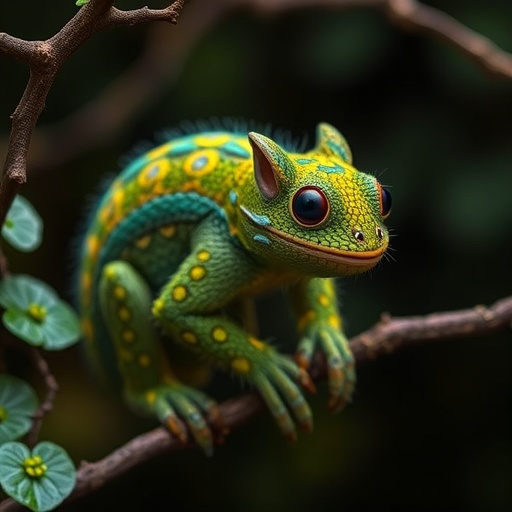
In the realm of wildlife conservation, a long-standing strategy known as assisted gene flow — the relocation of genetically diverse individuals from large, stable populations into smaller, at-risk groups — has been heralded as a critical tool for boosting endangered species’ survival prospects. Yet, new genomic research on the Eastern massasauga rattlesnake challenges the simplistic notion that more genetic variation is always beneficial. This compelling study suggests that introducing diverse donor animals into small, isolated populations may inadvertently carry a heavier burden of harmful mutations than previously accounted for, revealing a nuanced and paradoxical landscape of conservation genetics.
At the heart of this investigation lies an analysis of whole genome sequences from 152 Eastern massasauga rattlesnakes sampled across 14 populations in the United States and Canada. The principal question the researchers tackled was whether donors drawn from genetically diverse populations genuinely provide a net genetic benefit to smaller, inbred groups. Using cutting-edge computational approaches, they examined the balance between adaptive (beneficial) and deleterious (damaging) mutations transferred during hypothetical assisted gene flow scenarios. Contrary to prevailing assumptions, the results indicated that while donor individuals contributed some positive genetic variants, they also introduced a substantial increase in harmful mutations that could pose long-term risks to recipient populations.
This revelation emerges amid a scientific paradox. On one hand, empirical evidence shows that genetic rescue via assisted gene flow often leads to immediate increases in population size by alleviating inbreeding depression, thereby boosting short-term survival. On the other hand, the detailed genomic data hint that the introduction of deleterious mutations might undermine this success over extended periods. “The genetic data suggest that genetic rescue efforts might be a wash, or potentially risky in the long term,” explained H. Lisle Gibbs, a professor at Ohio State University and lead senior author of the study. His words highlight a critical dimension rarely addressed in conservation practice: that the evolutionary consequences of gene flow cannot be gauged solely by population counts.
.adsslot_KNWMLl3yh7{width:728px !important;height:90px !important;}
@media(max-width:1199px){ .adsslot_KNWMLl3yh7{width:468px !important;height:60px !important;}
}
@media(max-width:767px){ .adsslot_KNWMLl3yh7{width:320px !important;height:50px !important;}
}
ADVERTISEMENT
The researchers innovated a gene-by-gene framework for parsing whole-genome data, systematically classifying individual mutations according to their functional impact. Each gene, consisting of two alleles, was scrutinized for single-nucleotide polymorphisms (SNPs) that could either enhance or impede the organism’s adaptive capability. By quantifying both the beneficial and deleterious variants within donor and recipient pools, the study provides an unprecedented, fine-grained view of the genetic “package” introduced during translocation events, marking a departure from previous analyses that largely treated genetic diversity as uniformly positive.
Intriguingly, the study found that donor snakes from genetically rich populations did not simply bring the “good” alleles to the inbred population but also carried a significant load of mildly to severely damaging mutations, including loss-of-function variants that effectively disable certain genes. For example, one modeled scenario indicated donor snakes could increase the recipient population’s beneficial variants by 34%, but simultaneously raise moderately damaging mutations by 36% and the most severe loss-of-function mutations by 32%. This complex mix raises critical questions about the efficacy and safety of assisted gene flow, emphasizing the need for a comprehensive genetic risk assessment prior to implementing such conservation strategies.
While these findings might appear discouraging, Gibbs and collaborators caution against dismissing assisted gene flow outright. They stress the essential role of ecological and environmental factors that work alongside genetics to promote species persistence. It’s suggested that external ecological conditions—including habitat quality, predator-prey dynamics, and climate—may provide a buffering effect that allows populations to withstand the influx of deleterious genetic variants. This ecological support could be what drives the observed growth of recipient populations after assisted migration, despite the genetic risks identified.
Another critical dimension addressed by the study involves local adaptation—the phenomenon whereby populations evolve traits finely tuned to their specific environments. Skeptics of assisted gene flow often fear that translocating individuals from different regions could disrupt these local adaptations, inadvertently reducing fitness. However, the research team found that only a small fraction (7%) of the adaptive mutations present in donor snakes were tied to adaptation to local regions within Ohio, suggesting that maladaptation due to gene flow may represent a minor concern for this species. This insight debunks some assumptions and opens the door for broader application of genetic rescue across varied landscapes.
The implications of this research extend well beyond the Eastern massasauga rattlesnake. The statistical methodologies developed to measure and balance adaptive and deleterious variation can be readily applied to other threatened species for which genome sequence data exist. “Our results shine a spotlight on the complexity of genetic rescue and underscore the importance of incorporating a genomic risk assessment into conservation decision-making,” Gibbs said. By quantifying the mutation load that donor populations may carry, conservationists can better strategize gene flow interventions to maximize benefits while minimizing inadvertent harm.
The study also underscores the critical need for integrating evolutionary biology with conservation ecology. Genetic interventions cannot be designed in isolation; instead, they must be embedded within a broader ecological framework that accounts for habitat suitability, demographic dynamics, and environmental pressures. This holistic perspective may ultimately dictate the success or failure of conservation programs aimed at genetic rescue, highlighting the multifaceted nature of species preservation in the Anthropocene.
Moreover, the findings challenge the conservation community to rethink how genetic diversity is interpreted. While greater diversity has traditionally been equated with enhanced adaptive potential, this research reveals the hidden risk of accumulating subtle but pervasive harmful mutations in donor populations. It calls for refined metrics that go beyond simple heterozygosity or allele counts, incorporating functional genomics to evaluate the net effect of genetic variants on fitness.
Finally, the study raises urgent questions about the long-term monitoring of populations following assisted gene flow. Immediate demographic boosts in endangered populations might mask insidious genetic consequences that unfold over multiple generations. Conservationists are thus encouraged to implement genomic surveillance and adaptive management strategies to detect and respond to these dynamics in real time, ensuring that genetic rescue fulfills its promise without unintended setbacks.
In conclusion, this pioneering genomic evaluation of assisted gene flow in an endangered rattlesnake species reveals a complex interplay of beneficial and harmful mutations introduced during conservation interventions. The research exposes the paradoxical potential for genetic rescue efforts to both aid and imperil vulnerable populations, urging a more nuanced, data-driven approach to managing genetic diversity in the wild. Integrating genomic insights with ecological understanding and long-term monitoring will be essential for safeguarding endangered species in an era of rapid environmental change.
Subject of Research: Genomic assessment of assisted gene flow effects on endangered Eastern massasauga rattlesnake populations.
Article Title: Genomic Evaluation of Assisted Gene Flow Options in an Endangered Rattlesnake
News Publication Date: 7-Jul-2025
Web References:
Molecular Ecology Journal: http://dx.doi.org/10.1111/mec.70014
SNP Information: https://medlineplus.gov/genetics/understanding/genomicresearch/snp/
Assisted Gene Flow Candidate Species Study (2023): https://academic.oup.com/jhered/article/114/4/354/7091440
References:
Mathur, S., & Gibbs, H.L. (2025). Genomic evaluation of assisted gene flow options in an endangered rattlesnake. Molecular Ecology. DOI:10.1111/mec.70014
Keywords: Assisted gene flow, genetic rescue, Eastern massasauga rattlesnake, genetic diversity, deleterious mutations, adaptation, conservation genetics, SNP, whole genome sequencing, endangered species, evolutionary biology, ecological factors
Tags: adaptive versus deleterious mutationsassisted gene flow in endangered speciesbalancing genetic benefits and risksconservation genetics challengesEastern massasauga rattlesnake studygenetic diversity in conservationgenomic research in wildlifeharmful mutations in geneticsimplications of gene flowisolating small animal populationsmutant burden in conservation effortswildlife conservation strategies






